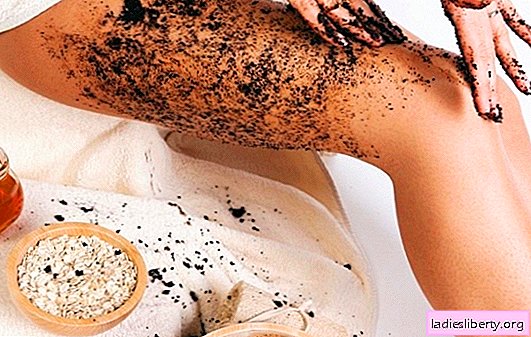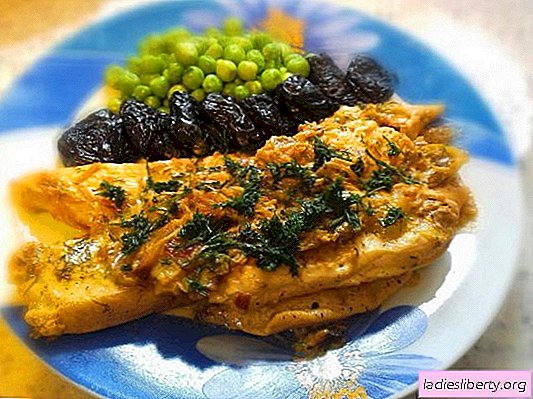
Sudden changes in the weather, temperature changes, stresses, hard work adversely affect our skin.
To support the epidermis in a tone and give it a radiant look apply nourishing masks.
They are very easy to make and apply at home.
The correct selection of the mask, depending on the skin type and needs of the body, affects the success of the procedures.
You need to know the rules and features of their application.
Why it is better to collect nutritious masks at home:
• ease of preparation;
• contain natural and known ingredients;
• low cost;
• the ability to vary the composition (supplement with vitamins).
In winter, masks should contain the highest amount of vitamins..
It is better to include such ingredients in them:
• vegetables (cucumbers, tomatoes, potatoes);
• fruits (bananas, lemons, apples, avocados);
• greenery;
• honey;
• eggs;
• dairy products (kefir, sour cream, cream, yogurt);
• decoctions of herbs (chamomile);
• oils (vegetable, cosmetic, essential);
• vitamins.
For masks in the summer, you can include the following components:
• glycerin;
• gelatin;
• aspirin;
• dimexide.
Nourishing face mask at home: basic principles of application
To get an excellent result from a nourishing mask is not so difficult if you first become familiar with the features of preparation and use.
For dry epidermis, the following ingredients are used:
• Dairy production;
• Butter;
• Yolk.
It is better to nourish the skin prone to fat:
• Citrus;
• Protein;
• Skim milk.
Normal skin fit:
• Honey;
• eggs;
• vegetables;
• Liquid - decoctions of herbs.
Oil and honey are slightly warmed before use, and eggs and essential oils do not tolerate high temperatures, as they lose their properties.
It is better to use wooden or ceramic dishes, but it will be ideal - a glass bowl, it is better to refuse metal.
Be sure to check your body's response to the mask. This can be done by brushing the wrist with the prepared solution and seeing the skin’s response to the effect during the day. Itching and redness are a sign of the onset of an allergic reaction, i.e. The components of the nutritional mask are incompatible with your skin.
The mask is applied with massage movements. Do not rub the mixture into the skin. Movement should be light and smooth, corresponding to the contours of the face.
The optimal contact time of the mask with the skin is 10-30 minutes, where the minimum period (10 minutes) is intended to affect the sensitive epidermis, and the maximum (30 minutes) - prone to grease.
To remove the mask using warm milk or a decoction of herbs.
A nutritional mask should be used no more than twice a week.
The benefits of nourishing masks
When the skin lacks nutrition, it begins to lose its healthy appearance and looks worse. Therefore, the epidermis, especially in the winter-spring period, must be given additional substances and vitamins. Health helps to maintain nourishing masks.
They perform the functions of:
• Deliver beneficial substances;
• Increase oxygen intake;
• Increase blood flow to the skin;
• Recovery of damaged cells;
• Protection from adverse environmental effects.
The result of regular use of masks is to improve the appearance of the skin and restore its health.
When it is preferable to apply nutritious masks:
• Winter-spring period (prevention of vitamin deficiency);
• Conditions for sudden changes in temperature;
• Stressful situations;
• Hard work;
• Work in the chemical industry.
Nourishing masks increase skin elasticity and deliver beneficial substances to cells. Without such prevention, the skin ages faster.
Masks are divided into categories:
• Winter - involves the use of an oil base.
• Spring - based on the use of fruits and vegetables.
Application Rules:
1. Make up remover. Cleanse the skin thoroughly.
2. Mask application. Massage movements. The face can be covered with a cloth or foil.
3. Withdrawal. When the mask is based on oil components, remove it with a cotton pad. In all other cases, a decoction of herbs. After grease with cream.
Time spending
It is important to carry out cosmetic procedures at the most favorable time. There are hours when the use of nourishing masks is useless. Therefore, it is worth knowing the skin's life mode:
• 8-10: you can make any mask;
• 11-12: nourish oily skin;
• 15-18: food is useless;
• 18-23: skin cleansing and nutrition;
• 23-24: ideal time for nourishing masks.
It is very important to use only fresh products.
Nourishing facial mask at home: for dry skin
The mask is based on ingredients containing fats. It is very important to nourish dry skin in the winter.
Honey Masks
Honey is a unique natural product. Mask founder nourishes dry epidermis. It can also be used for combination skin types.
Honey is a strong allergen. Before use, control the reaction on the wrist. It can not be used for diabetes and dilated vessels on the face.
Mask Recipes:
1. Ingredients: olive oil (5 ml), buckwheat honey (12 g), yolk, oatmeal (8 g), lemon juice (6 cap.). Mix and beat until foam appears.
2. Ingredients: half yolk, grape seed oil, honey (30 g), carrot juice (20 ml).
3. Ingredients: milk (20 ml), wheat flour (10 g), honey (30 g), quail egg. Mix milk and wheat flour, add honey to the mixture.
Fruit masks
Fruits are an indispensable product in the spring months, as they have an amazing amount of vitamins that are so necessary for dry skin during this period.
Features:
• Need fresh and ripe fruits;
• The mixture is not stored;
• After the cream is not applied;
• Evening application.
Mask Recipes:
1. Ingredients: strawberry juice (48 ml), oatmeal (15 g), lanolin (8g). Lanolin is heated before use. Mix juice and flour.
2. Ingredients: melon and plum pulp, vegetable oil. Fruits must be peeled, the ingredients are mixed.
3. Ingredients: sweet fruit juice (16 ml), sour cream (9 ml), vegetable oil (5 ml), yolk, barley flour.
Nourishing face mask at home: for oily skin
One of the main tasks of the mask for prone to oily skin - the normalization of the sebaceous glands. It should not only nourish the epidermis, but also cleanse, soothe and treat it.
Protein masks
Protein is part of the egg, is a building material for cells. Protein masks nourish, dry and reduce pores. The action takes place as quickly as possible. After the first time you will feel the effect.
Mask Recipes:
1. Components: protein, lemon juice (3 ml). Beat to a foamy state. The application is made in several layers, the mask is washed off by brewing tea.
2. Components: protein, sour apple varieties, starch. The apple is mixed with protein, pre-whipped into a foam, to the resulting solution is added potato starch.
3. Ingredients: protein (2 eggs), honey (30 g), peach oil, oatmeal flakes (50 g).
Yeast Masks
Only baker's yeast is used, dry - unsuitable. The mask should dry on the face. Removed - water.
Mask Recipes:
1. Ingredients: yeast, yogurt, plantain juice.
2. Components: hydrogen peroxide (3%), yeast. Apply a thick layer.
3. Ingredients: yeast, flour (rye). Mix and leave for a day in a dark place.
Nourishing facial mask at home: for normal skin
Ether base mask
Essential oils are excellent for nourishing normal skin types.
Components: fruit puree, yolk, broth of oatmeal flakes, essential oil (any of: spruce -2 cap., rosewood - 4 cap., orange - 2 cap.). Add soap suds well to the mixture.
Nourishing face mask at home: for fading skin
With age, the skin needs to be given more time and attention, as the regeneration processes slow down and cell metabolism changes.
For dry skin, a mask of components is suitable:
• Honey (2 tablespoons);
• Infused green tea;
• Water;
• Hercules flakes.
Honey and green tea are mixed together and add flakes and water. The resulting solution was placed in a water bath. Apply the mask warm, then cover the face with a napkin or a towel. The mask lasts 20 minutes and is washed off with water.
For skin that has lost its elasticity, a mask of components is perfect:
• Yolk;
• Honey (h. Spoon);
• Glycerol.
Ingredients mix.
Or
• White yogurt (100 gr)
• Honey (Art. Spoon)
• Grapefruit zest
Mix it up. Hold for 15 minutes and rinse with green tea.
Nourishing face mask at home: tricks and tips
Useful notes in the application of masks.
You can change the composition of the masks depending on what vitamin is not enough for the skin:
• rash (retinol);
• change in elasticity (tocopherol);
• dermatitis (niacin);
• pallor (cyanocobalamin);
• redness and peeling (riboflavin).
The required effect of the mask is achieved by adding vitamins to the composition, since most of the nutrients pass into the cells.
Strengthening the action involves the following steps:
• proper nutrition;
• proper amount of sleep;
• take vitamins (especially in spring and autumn);
• beware of stress.
The above recommendations will help restore your body and fill your skin with vitamins.
It is important to remember that if there is no mention of vitamins in the recipe, you can safely add them.
To keep your skin youthful and beautiful, use nourishing face masks. Cooking them at home is not difficult. The main thing to know: recipes, skin features and applications. Also do not forget to test the resulting mixture on your wrist to identify allergic reactions. These recommendations will help keep your skin in amazing condition.











